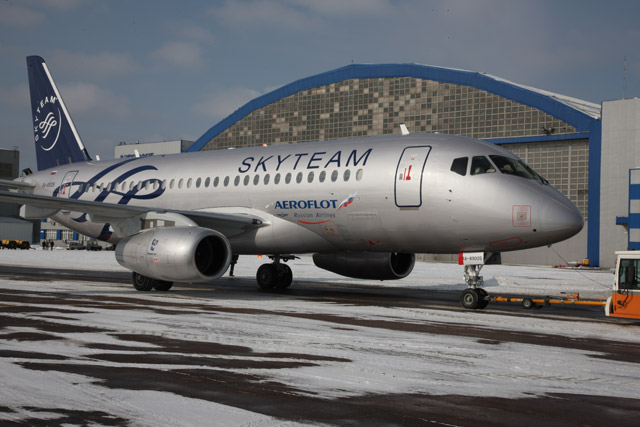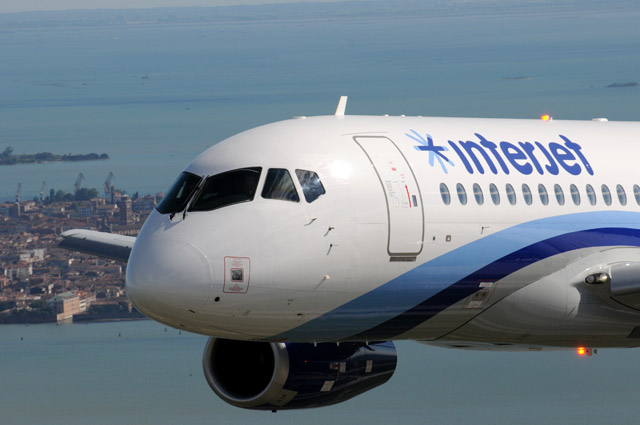United Aircraft has put its faith in the Superjet to play a lead role in Russia's civil ambitions, and despite a lack of recent orders, Sukhoi is confident it can deliver.
Sukhoi's civil aircraft division will head into the MAKS air show, the main event on its home territory, aiming to lift an order book which has largely been dormant for over a year.
Russian carrier Transaero was the last customer to sign for the type in any firm capacity when it opted for up to 16 Superjets in June 2012 - an unusual decision for an airline which had operated Boeing types almost exclusively, limiting its Russian-built complement to a handful of Tupolev Tu-214s.
 |
|---|
| Superjet International Aeroflot's sixth Superjet was delivered in early March 2012, carrying the livery of global alliance SkyTeam |
United Aircraft presented its annual report to shareholders at the end of June, which stated that the Superjet had 170 orders from Russian and foreign customers - although the details of the backlog remain opaque.
Russian lessor Ilyushin Finance has been negotiating for 20 and appeared to move closer to a firm agreement during the Paris air show as it signed a preliminary pact for the aircraft, for delivery from 2015.
Ilyushin Finance is intending to take 15 of the basic Superjet variant, configured for customers in Southeast Asia and the Middle East, as well as five of the new long-range version.
The long-range aircraft emerged earlier this year and Sukhoi has been aiming to achieve certification before the MAKS show.
Russian energy firm Gazpromavia is in line to take the first example by the end of this year, and crew training for the carrier on the type has already started.
Sukhoi has also been working to obtain certification for Category IIIa landings, an effort interrupted in mid-July when one of its prototype aircraft, 95005, suffered a gear-up touchdown at Reykjavik's Keflavik airport during a series of approach tests. Despite the setback, the airframer remained confident that the approval will not be held up.
CIVIL TYPES
United Aircraft is relying on the Superjet to support its efforts to become a stronger player in the civil aircraft sector. It says about a third of its backlog of 740 aircraft are civil types.
It produced 12 Superjets last year - more than half its output of 22 civil airframes - the others comprise four Tu-214s and Tu-204s, four Antonov An-148s and a pair of Ilyushin Il-96s.
Chairman Vladimir Dmitriev says the revenue share of civil aircraft exceeded 10% and that production of Superjets has developed at a "good pace", more than doubling that of 2012.
Dmitriev says the company intends to return the domestic civil aviation industry to the strong position it held in the 1970s and 1980s, creating a product line which can compete with those of other major manufacturers.
United Aircraft wants to double its overall civil output to 40 aircraft this year. President Mikhail Pogosyan admits the target is "rather ambitious" but insists: "We'll handle it."
"Firm orders for the Superjet aircraft give us the confidence to increase production," he says. The company's immediate strategic target is to build at least 17 in a year, while putting in place measures to cut production costs. United Aircraft also wants to improve the type's fuel consumption and performance, and lower cabin noise, having gathered data from the operation of early aircraft.
 |
|---|
| Superjet International Further Western exposure is crucial to the firm's strategy |
Pogosyan is optimistic that the production rate for the Superjet will reach three per month over the second half of this year and increase further next year to enable the airframer to turn out a total of 40 in 2014.
As part of its production drive, the company has commissioned a new facility in Kazan, Tatarstan, which will start producing composite structures for Superjets this year.
United Aircraft is establishing centres of competence for new aerostructure requirements and the facility, KAPO-Kompozit, will also be adapted to handle the manufacturing of components for the Irkut MC-21.
Sukhoi has progressed with efforts to smooth its production process, delivering in May the first Superjet to Aeroflot to be configured with an upgraded cabin sought by the carrier.
Aeroflot, which ordered 30 Superjets, took its initial 10 in a lightweight layout, but is intending to swap them out as the newly-fitted aircraft arrive. The enhancements include a more advanced flight-management system and weather radar, as well as video cameras, cabin lighting controls and an extra cabin crew working position.
ADDED EXTRAS
Sukhoi adds that the cabin is fitted with additional passenger ventilation outlets, extra oxygen masks, and the aircraft has three lavatories and four galleys installed.
However, a more significant delivery took place during the Paris air show when Mexican carrier Interjet formally received the first of 20 Superjets. The initial handover was performed by Sukhoi's Italian joint venture Superjet International, which was established to take on the task of marketing the jet to Western customers.
It has been fitted with 93 seats, at Superjet International's Venice facility, with a part of the cabin interior developed by the Italian design firm Pininfarina. It aims to give passengers the "crucial" impression of spaciousness and comfort compared with other aircraft in the same category, says president Paolo Pininfarina.
Hours before the prototype Superjet accident at Keflavik, the first Interjet aircraft passed through the airport on its delivery flight to Toluca. One of the airline's pilots, on board the ferry flight, described the aircraft as "amazing".
Interjet plans to begin revenue flights with the aircraft around August, with the aircraft having to perform 100h of non-revenue service to satisfy Mexican regulations.
Chief executive Jose Luis Garza says the airline will have all 20 Superjets in its fleet by the end of next year, serving "mid-density routes" in Mexico which, he states, the aircraft "perfectly matches". However, he adds that the type could also be used for US services with flights to Arizona and Texas.
"It means our aircraft will be seen flying to and from the USA, which is an important promotion for us in that market," says Pogosyan.
Italian entities have been closely involved with the Superjet programme since 2005, most prominently through Alenia Aermacchi's shareholdings in the airframer as well as Superjet International.
However, tensions between the two sides surfaced during the Paris air show when Alenia parent Finmeccanica denounced their relationship as "difficult" and "expensive".
"We signed an agreement [regarding the Superjet] which has been implemented in an unsatisfactory way for quite a long period of time," said Finmeccanica's new chief executive Alessandro Pansa.
Most of the Superjets delivered have gone to Russian and Asian customers, and the Interjet handover follows frustrated efforts to place the aircraft with Italian operators.
Pansa suggested the relationship should be "reviewed and restructured", but stopped short of threatening to withdraw. Meanwhile, Alenia chief Giuseppe Giordo diplomatically stated that the programme is "important" and "strategic" and - with the Interjet delivery - was starting to generate results.
The friction echoes an earlier rift between the Russian and French sides - Saturn and Snecma - in the PowerJet engine joint venture, which builds the SaM146 for the Superjet.
PowerJet has turned out 64 engines and, by the beginning of June, 39 had been shifted to operational service. The company claims a despatch reliability of 99.89%.
It intends to produce 52 engines this year, adding that its production rate is being determined "according to the needs of [Sukhoi]".
As part of the work to enhance the engine, Snecma performed a series of tests in June to examine an alternative fuel for the SaM146, using a 90:10 blend of regular Jet-A1 fuel and a sugar-based product known as farnesene.
Source: Flight International
















